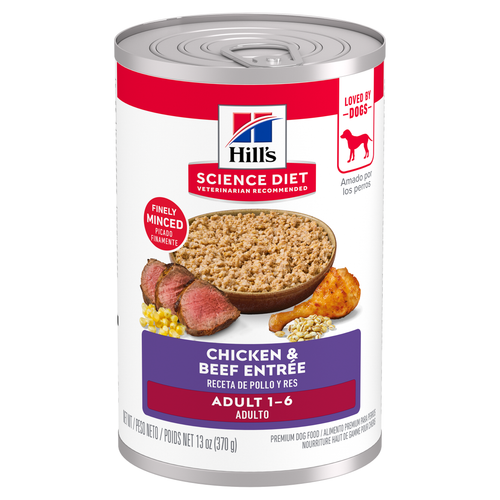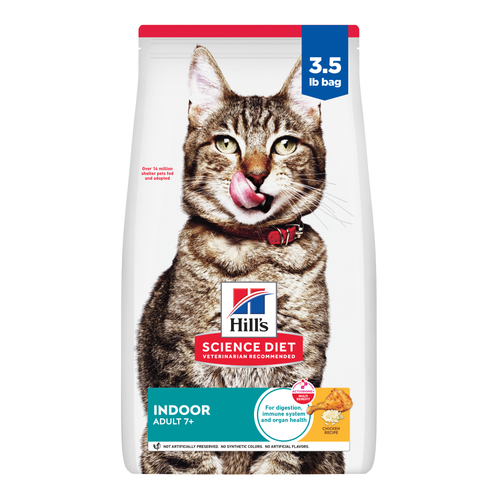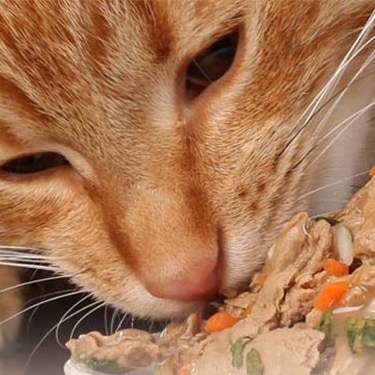
-
Find the right food for your petTake this quiz to see which food may be the best for your furry friend.Find the right food for your petTake this quiz to see which food may be the best for your furry friend.Featured products
 Adult Large Breed Chicken & Barley Recipe Dog Food
Adult Large Breed Chicken & Barley Recipe Dog FoodSupports healthy joints, lean muscle, and beautiful coat for large breed dogs
Shop Now Hill's Science Diet Adult Chicken & Beef Entrée Dog Food
Hill's Science Diet Adult Chicken & Beef Entrée Dog FoodChicken & Beef Entrée in a delicious loaf with complete & balanced nutrition to help keep adult dogs active and healthy
Shop Now Adult Chicken & Barley Recipe Dog Food
Adult Chicken & Barley Recipe Dog FoodSupports lean muscle and beautiful coat for adult dogs
Shop NowFeatured products Adult Turkey & Liver Entrée Cat Food
Adult Turkey & Liver Entrée Cat FoodPrecisely balanced nutrition with the delicious taste of minced turkey & liver to help fuel the energy needs of cats during the prime of their life
Shop Now Adult 7+ Indoor Chicken Recipe Cat Food
Adult 7+ Indoor Chicken Recipe Cat FoodSupports energy level and beautiful fur in mature indoor cats
Shop Now Senior Vitality Adult 7+ Tuna & Vegetables Stew
Senior Vitality Adult 7+ Tuna & Vegetables StewImproves Everyday Ability to Get Up & Go
Shop Now -
Dog
- Dog Tips & Articles
-
Health Category
- Weight
- Food & Environmental Sensitivities
- Urinary
- Digestive
- Joint
- Kidney
-
Life Stage
- Puppy Nutrition
- Adult Nutrition
- Senior Nutrition
Cat- Cat Tips & Articles
-
Health Category
- Weight
- Skin & Food Sensitivities
- Urinary
- Digestive
- Kidney
-
Life Stage
- Kitten Nutrition
- Adult Nutrition
Featured articles How to Properly Mix Wet & Dry Pet Foods
How to Properly Mix Wet & Dry Pet FoodsAn Orange cat eating from a bowl filled with mixed food
Read More What Is Littermate Syndrome? Pet Adoption Guide
What Is Littermate Syndrome? Pet Adoption GuideLearn more about littermate syndrome in dogs and cats and how to successfully navigate adoption and early socialization processes.
Read More The Science Behind Our Love for Pets
The Science Behind Our Love for PetsLearn the scientific reasons why we have such strong connections with our pets, and what science says about the love between humans and our furry friends.
Read More -


Despite our best efforts, dogs sometimes get hurt. One part of being a responsible pet parent is knowing how to answer the question, "What can I put on my dog's cut?" and how to treat a cut on a dog at home. Having a dog-specific first aid kit on hand, knowing what to use to treat a cut at home and recognizing when your dog needs veterinary attention are all important parts of pet care. If your furry friend is wounded, here is how to treat a cut on a dog.
How to Treat a Cut on a Dog
Use this step by step guide to treat your dog if they get a wound:
 Step 1: Assess and Stop Any Bleeding
Step 1: Assess and Stop Any Bleeding
Before you can answer "What can I put on my dog's cut?" you need to ask yourself, "Is the wound bleeding?" If the wound is oozing blood, then you can apply gentle pressure with a small towel or gauze square, depending on the size of the wound. Ask your dog to sit or lie down, and hold the towel in place over the wound with your hand with just enough pressure to stop the bleeding. If the dog is calm, most wounds will clot and stop bleeding within a couple of minutes. If the dog is excited, then it will take longer because of high blood pressure. If the wound is pumping blood, that means a larger blood vessel has been cut, and you will need to keep pressure on the wound until you get to a veterinary clinic.
Step 2: Clean
If the wound has debris in it, like mud or leaves, flush the wound with a generous amount of lukewarm tap water to rinse dirt and bacteria off the surface of the wound.
Step 3: Disinfect the Wound
This brings us to the million dollar question: "What can I put on my dog's cut?"
Dilute betadine is an excellent disinfectant to keep in your first-aid kit. A good alternative to betadine is diluted chlorhexidine. Hydrogen peroxide should not be used to clean the wound because it is very damaging to skin cells, and can actually delay wound healing.
Start by applying disinfectant to the wound. If it is a bite wound, squirt disinfectant into the puncture hole to flush out bacteria and contact your veterinarian for advice as bite wounds are more likely to develop secondary infections. After the wound is cleaned and disinfected, apply a thin layer of triple antibiotic ointment to the surface of the wound.
What Can I Put on My Dog's Cut: Additional Precautions
 It's important to deal with cuts and scrapes early to avoid infection. If you wait too long to treat a wound, then it can become a much bigger, more painful problem that takes longer to heal and requires additional expensive treatment.
It's important to deal with cuts and scrapes early to avoid infection. If you wait too long to treat a wound, then it can become a much bigger, more painful problem that takes longer to heal and requires additional expensive treatment.
Dogs that are wounded are hurt and scared, and may react aggressively out of fear. Before you ask yourself how to treat a cut on a dog, ask yourself if you should. Only attempt to take care of your dog's wound at home if you are confident that your dog won't bite anyone who tries to help. Use a muzzle (you can make one at home) and get somebody to help you. When treating a wound yourself, it is important to stay calm as your dog can pick up on your stress.


Tasty Tips
When to See a Vet
How do you know when you need to take your dog to the vet and when you can treat a cut at home? Here are the types of injuries that need veterinary attention:
- Bite wounds as they're likely to get infected
- Deep cuts that fully penetrate the skin
- Cuts longer than an inch
- Cuts that the dog won't leave alone
- Cuts that don't heal within a week
- Cuts that look infected (redness, heat, swelling, discharge that looks like pus, odor)
- Any injury that leaves your dog acting sick (excessive tiredness, loss of appetite, vomiting or diarrhea, etc.)
- Anything wound you are unsure or worried about
If you've treated the wound adequately, it should heal in less than a week. Anything that takes longer than that or shows signs of infection should be addressed by a vet. If you follow these simply steps, you'll be ready to play nurse the next time your pup gets hurt. Your dog and your vet with thank you for practicing good hygiene and safety when it comes to treating wounds at home.


Dr. Sarah Wooten graduated from UC Davis School of Veterinary Medicine in 2002. A member of the American Society of Veterinary Journalists, Dr. Wooten divides her professional time between small animal practice in Greeley, Colorado, public speaking on associate issues, leadership, and client communication, and writing. She enjoys camping with her family, skiing, SCUBA, and participating in triathlons.
Related products

Chicken & Barley Entrée in a delicious loaf with great taste and precisely balanced nutrition to support 5 essential building blocks for lifelong health

Supports healthy joints, lean muscle, and beautiful coat for large breed dogs

Supports lean muscle and beautiful coat for adult dogs

Chicken & Beef Entrée in a delicious loaf with complete & balanced nutrition to help keep adult dogs active and healthy
Related articles

Wondering where can I buy a dog? Consider adoption and explore the pros and cons of adopting a dog from a breeder versus an animal shelter.

Your dog's coat and skin are a big part of your dog's overall health. Ensure you keep your dog's coat healthy, by following these simple tips.

Learn how to help keep your dog's immune system in tip-top shape, including nutritional immune system support for dogs and other strategies.

Discover how the field of dog science is giving us more and more insights into the inner workings of our furry best friends.

Put your dog on a diet without them knowing
Our low calorie formula helps you control your dog's weight. It's packed with high-quality protein for building lean muscles, and made with purposeful ingredients for a flavorful, nutritious meal. Clinically proven antioxidants, Vitamin C+E, help promote a healthy immune system.
Put your dog on a diet without them knowing
Our low calorie formula helps you control your dog's weight. It's packed with high-quality protein for building lean muscles, and made with purposeful ingredients for a flavorful, nutritious meal. Clinically proven antioxidants, Vitamin C+E, help promote a healthy immune system.

